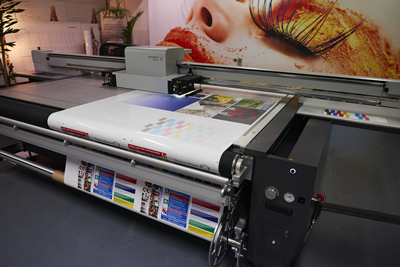This is not the cheapest printer but is it good value for money? Nessan Cleary puts it to the test.
SwissQ Print has built up a good reputation for the quality of its flatbed printers so I’ve been looking forward to testing one of these. There are four printers in all, ranging from the entry-level Oryx to the top end Nyala, recently updated to the Nyala2. For the test we got our hands on the mid-range Impala.
This is a 2.5 x 1.6m UV-curable flatbed. It’s a fairly solid machine, with the company trading heavily on the Swiss reputation for quality manufacturing. SwissQ itself was set up when Zund decided to concentrate on its digital cutters so the management can claim a proven history in developing wide-format printers.
The Impala, as with all of the SwissQ printers, has a modular design with a number of options that can be added at the factory or upgraded later in the field. Indeed, SwissQ has also ensured that later developments can be retrofitted to the earlier models. Options include extension tables to handle larger boards and a Tandem mode that lets you set up one half of the bed while printing on the other for maximum productivity. There’s a choice of printheads. The model on test used Konica Minolta 1024 printheads but the printer can be ordered with the faster KM1024i printheads. Thus, for example, in the Quality mode of 720 x 720dpi, the KM1024 heads should produce 18m2/hr, where the KM1024i heads can run at 24m2/hr. Unfortunately, it’s not possible to upgrade to the faster heads at a later date.
The base model uses CMYK but there are nine channels, with one head per colour and an option to add a second row of heads for faster production. You could also use two sets of CMYK, nearly doubling the speed. Steve Pridham, sales manager with Spandex and responsible for distribution in the UK, says that most people take six colours with white and that about half also take varnish. He adds: “Varnish helps to lift the colours to give them more punch.”
The heads are not covered under warranty but Pridham says that he rarely has to change a printhead and that they should last for four to five years. There are anti-crash sensors on both sides of the carriage, as well as anti-static units. It’s also possible to map between failed nozzles.
Pridham says that the daily maintenance takes about two minutes, adding: “We do a purge in the morning and wipe the heads manually. Then we wet purge at the end of the day.” You can leave it for a week with the same process but you will have to clean the heads if you have left them for two hours or more.
SwissQ has opted for Sun Chemical UV inks. The ink is reasonably flexible and doesn't chip when routed or cut but does seem to be very scratch resistant. It can be stretched by up to 220% and so should be suitable for vehicle graphics. Each colour ink comes in five litre containers, which are placed directly into the machine.
For curing, the Impala uses mercury lamps from Integrated Technologies. These are normally run at 71% power and should last for 1,000 hours but some people use them for 2,000-3,000 hours. The curing can be varied in relation to the amount of ink that is laid down to give different effects like satin gloss.
There’s a fairly powerful vacuum, which is always on so that turning it on just opens a flap and the vacuum activates straightaway. There's an adjustable slider across the front of the table that lets you restrict the vacuum just to the width that you are printing.
In common with many flatbeds these days, there’s an option to add a roll feeder to the front, with the media stretched across the bed to a take-up roll at the back. The roll-fed option takes up to 180kg weight. It’s possible to load two separate rolls side by side though they would have to be of a similar thickness so that they feed at the same rate. However, the roll-feeder is about ten percent slower than flatbed printing.
The printer will work with quite a few Rips, though Pridham recommends Caldera. He points out that it has a number of nice features: “Caldera lets you put the varnish down only where there is ink which would be difficult to do in the design stage. You can control the start of the varnish according to the density of ink.”
The machine is run from a separate Windows PC which comes with the printer with its own pedestal. There's an additional control panel in the pedestal for mechanical functions such as moving the gantry and feeding the material through the roll.
The control station shows the condition of the ink tanks, the printheads and the lamps. But it also has a lot to do with the final set up of each job. Thus the Rip might deal with the sizing, colour management and printer marks. But the control station lets the operator determine the number of passes and the curing.
The base configuration starts at £155,000, which includes four colours with one KM1024 printhead for each colour and a full set of inks. The price includes the Caldera Rip, installation and five days training. This price rises to £177,000 for the KM1024i printheads.
The printheads are not covered under warranty. Replacement print heads cost £2,900 for the KM1024 and £3,700 for the KM2014i heads.
The colour inks cost £416 for five litres. The white ink costs £105 per litre and varnish is £90 per litre.
The roll-fed option costs £12,000 and there’s a choice of 2.5 or 3.2m width. It comes with a warranty of 12 or 24 months. Spandex offers an extended warranty that mirrors the SwissQ warranty for £6,000 for 12 months.
{jathumbnail off}


